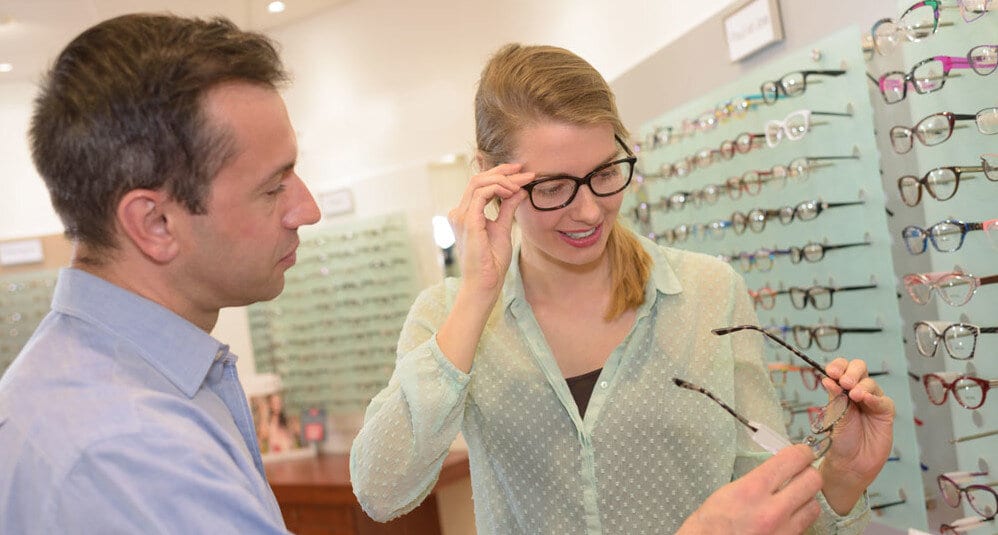The question of whether blue light will negatively affect your vision has continued to gain popularity between eye doctors and patients. The blue light emitted from different light sources and electronic devices daily is a rising concern as many believe it will increase their risk for macular degeneration and blindness. While these are valid concerns, there are many options available for consumers to reduce exposure and increase protection in the world today from computer glasses and blue light filters to limiting screen time each day.
What is Blue Light?
Sunlight consists of red, orange, yellow, green, blue, indigo, and violet light. White light is created from each of these light types being combined. Each light type has different levels of energy and wavelength. The wavelength of blue light is between 380 and 500 nanometers (nm). Blue light has shorter wavelengths and more energy when compared to other light types meaning the eyes have the potential of being exposed to a higher amount of wavelength, which can be damaging over time. Because of its short wavelength, high energy structure, blue light rays scatter easier than others when they hit the air and water molecules in the atmosphere. The quick scatter movement is what makes our sky blue.
Where Are You Exposed?
Sunlight is the largest source of blue light. However, over time suspicions have surfaced regarding the long-term effects of screen exposure. The exposure you receive from screens is small when compared to the sun, but concerns have evolved due to the proximity of the screens and the length of time individuals spend looking at them. Other than sunlight, there are many other sources of blue light that we’re exposed to daily.
- Fluorescent Light
- Compact Fluorescent Light (CFL) Bulbs
- LED Light
- Flat Screen LED Televisions
- Computer Monitors
- Smartphones
- Tablet Screens
Since sunlight is the largest known source of blue light, exposure does provide us with health benefits as well. From positively affecting your mood and improving alertness to enhancing your memory and regulating your circadian rhythm, many individuals have found that blue light has helped them depending on the time of day.
How Does Blue Light Affect Your Eyes?
Most of the visible blue light passes through the cornea and lens, with the retina being the final destination. Due to the strength of blue light, too much exposure may affect vision and could also cause the eyes to age prematurely. Too much exposure to blue light could lead to:
- Digital Eyestrain: Because blue light has high energy and short wavelength, it scatters more quickly than other light forms making it not easily focused. This occurrence creates reduced contrast leading to digital eyestrain. Individuals can identify eyestrain by sore or irritated eyes and trouble focusing.
- Retina Damage: Extended exposure to blue light can lead to damaged light-sensitive cells located in the retina. Damage to these cells can lead to macular degeneration, which, over time, can cause permanent vision loss.
If you begin to notice symptoms for either of these eye-related issues, it is encouraged to schedule a comprehensive eye exam to determine the health of the eye and get further suggestions from your doctor.

Protection Available Today
With awareness of the damage blue light can place on your vision on the rise, there are many options available today to decrease exposure to blue light. Whether you’re an individual that is exposed to a computer for long periods or are worried about your child’s screen time, there is undoubtedly a solution that will ease your mind.
Blue Light Filters
Filters are available for a variety of devices such as smartphones, tablets, and computer screens. Utilizing a blue light filter will help prevent significant amounts of blue light from reaching your eyes without altering the visibility of the image on your screen. There are many different types of blue light filters available for purchase, like thin tempered glass to protect your screen from scratches and further damage.
Protective Eyewear
There are a variety of lenses available from various manufacturers that help to reduce the effects of blue light. Computer glasses have a yellow tint to help ease digital eye strain and increase contrast on your devices. Anti-reflective lenses have glare-reducing and anti-reflective coatings to reduce glare, increase contrast, and block blue light from a variety of sources.
Limit Screen Time
According to Blue Light Exposed, 74% of teens aged 12 to 17 access the internet on cell phones, tablets, and other mobile devices at least occasionally. Placing limitations on screen use for yourself and those around you will give your eyes a rest by minimizing possible eye strain. Additionally, due to the effects extended exposure of blue light can have on your retina, being conscious of screen time will reduce damage to the light-sensitive cells and decrease the likelihood of macular degeneration.
Intraocular Lens (IOL)
Individuals with cataracts are encouraged to ask their surgeon what type of intraocular lens (IOL) will be utilized to replace the cloudy lens during cataract surgery. The lens of the eye is already a natural blue light filter that protects the eye from most ultraviolet light and some blue light, however, certain types of IOL can further protect the eye and retina from blue light. Those that go through with cataract surgery may also benefit from anti-reflective lenses or blue light filter lenses to provide further protection.
Begin Monitoring Your Blue Light Exposure
There are pros and cons when it comes to the effects of blue light on your eyes and well-being. Being aware and checking in with your body will help you determine how blue light may be affecting you. There are many resources and protective options available today to help minimize your exposure and lead you towards a healthier lifestyle. If you are experiencing any symptoms of digital eyestrain or retina damage, it’s encouraged to communicate with your doctor as any issues are better caught early on to allow for proper care.

